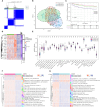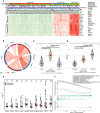Integrated analysis of single-cell RNA-seq and chipset data unravels PANoptosis-related genes in sepsis
- PMID: 38239341
- PMCID: PMC10795179
- DOI: 10.3389/fimmu.2023.1247131
Integrated analysis of single-cell RNA-seq and chipset data unravels PANoptosis-related genes in sepsis
Erratum in
-
Corrigendum: Integrated analysis of single-cell RNA-seq and chipset data unravels PANoptosis-related genes in sepsis.Front Immunol. 2024 Apr 23;15:1415915. doi: 10.3389/fimmu.2024.1415915. eCollection 2024. Front Immunol. 2024. PMID: 38715603 Free PMC article.
Abstract
Background: The poor prognosis of sepsis warrants the investigation of biomarkers for predicting the outcome. Several studies have indicated that PANoptosis exerts a critical role in tumor initiation and development. Nevertheless, the role of PANoptosis in sepsis has not been fully elucidated.
Methods: We obtained Sepsis samples and scRNA-seq data from the GEO database. PANoptosis-related genes were subjected to consensus clustering and functional enrichment analysis, followed by identification of differentially expressed genes and calculation of the PANoptosis score. A PANoptosis-based prognostic model was developed. In vitro experiments were performed to verify distinct PANoptosis-related genes. An external scRNA-seq dataset was used to verify cellular localization.
Results: Unsupervised clustering analysis using 16 PANoptosis-related genes identified three subtypes of sepsis. Kaplan-Meier analysis showed significant differences in patient survival among the subtypes, with different immune infiltration levels. Differential analysis of the subtypes identified 48 DEGs. Boruta algorithm PCA analysis identified 16 DEGs as PANoptosis-related signature genes. We developed PANscore based on these signature genes, which can distinguish different PANoptosis and clinical characteristics and may serve as a potential biomarker. Single-cell sequencing analysis identified six cell types, with high PANscore clustering relatively in B cells, and low PANscore in CD16+ and CD14+ monocytes and Megakaryocyte progenitors. ZBP1, XAF1, IFI44L, SOCS1, and PARP14 were relatively higher in cells with high PANscore.
Conclusion: We developed a machine learning based Boruta algorithm for profiling PANoptosis related subgroups with in predicting survival and clinical features in the sepsis.
Keywords: Boruta algorithm; PANoptosis; sepsis; single-cell RNA-seq; ssGSEA.
Copyright © 2024 Dai, Zheng, Wu, Chen, Deng, Tong, Liu, Shang and Qian.
Conflict of interest statement
The authors declare that the research was conducted in the absence of any commercial or financial relationships that could be construed as a potential conflict of interest.
Figures









Similar articles
-
Identification and Analysis of PANoptosis-Related Genes in Sepsis-Induced Lung Injury by Bioinformatics and Experimental Verification.J Inflamm Res. 2024 Mar 28;17:1941-1956. doi: 10.2147/JIR.S452608. eCollection 2024. J Inflamm Res. 2024. PMID: 38562657 Free PMC article.
-
Corrigendum: Integrated analysis of single-cell RNA-seq and chipset data unravels PANoptosis-related genes in sepsis.Front Immunol. 2024 Apr 23;15:1415915. doi: 10.3389/fimmu.2024.1415915. eCollection 2024. Front Immunol. 2024. PMID: 38715603 Free PMC article.
-
Key platelet genes play important roles in predicting the prognosis of sepsis.Sci Rep. 2024 Oct 9;14(1):23530. doi: 10.1038/s41598-024-74052-w. Sci Rep. 2024. PMID: 39384856 Free PMC article.
-
Molecular subtypes based on PANoptosis-related genes and tumor microenvironment infiltration characteristics in lower-grade glioma.Funct Integr Genomics. 2023 Mar 17;23(2):84. doi: 10.1007/s10142-023-01003-5. Funct Integr Genomics. 2023. Retraction in: Funct Integr Genomics. 2024 May 11;24(3):88. doi: 10.1007/s10142-024-01374-3. PMID: 36930242 Retracted. Review.
-
PANoptosis in Sepsis: A Central Role and Emerging Therapeutic Target.J Inflamm Res. 2025 May 13;18:6245-6261. doi: 10.2147/JIR.S513367. eCollection 2025. J Inflamm Res. 2025. PMID: 40386177 Free PMC article. Review.
Cited by
-
Integrated analysis of single cell-RNA sequencing and Mendelian randomization identifies lactate dehydrogenase B as a target of melatonin in ischemic stroke.CNS Neurosci Ther. 2024 May;30(5):e14741. doi: 10.1111/cns.14741. CNS Neurosci Ther. 2024. PMID: 38702940 Free PMC article.
-
Identification and validation of m6A RNA methylation and ferroptosis-related biomarkers in sepsis: transcriptome combined with single-cell RNA sequencing.Front Immunol. 2025 Mar 7;16:1543517. doi: 10.3389/fimmu.2025.1543517. eCollection 2025. Front Immunol. 2025. PMID: 40124361 Free PMC article.
-
A multi-omics strategy to understand PASC through the RECOVER cohorts: a paradigm for a systems biology approach to the study of chronic conditions.Front Syst Biol. 2025 Jan 7;4:1422384. doi: 10.3389/fsysb.2024.1422384. eCollection 2024. Front Syst Biol. 2025. PMID: 40809128 Free PMC article. Review.
-
Integration of Network Pharmacology, Transcriptomics, and Metabolomics Strategies to Uncover the Mechanism of Chaihuang Qingfu Pill in Treating Sepsis-Induced Liver Injury.Drug Des Devel Ther. 2025 Jun 2;19:4665-4688. doi: 10.2147/DDDT.S521626. eCollection 2025. Drug Des Devel Ther. 2025. PMID: 40486124 Free PMC article.
-
Exploring the Importance of ZBP1 in Sepsis: A Mini Review on It's Mechanisms and Progress.J Inflamm Res. 2025 Jul 25;18:9871-9878. doi: 10.2147/JIR.S527506. eCollection 2025. J Inflamm Res. 2025. PMID: 40740970 Free PMC article. Review.
References
-
- Anggraini D, Hasni D, Amelia R. Pathogenesis of sepsis. Sci J (2022) 1:332–9. doi: 10.56260/sciena.v1i4.63 - DOI
Publication types
MeSH terms
LinkOut - more resources
Full Text Sources
Medical
Research Materials

